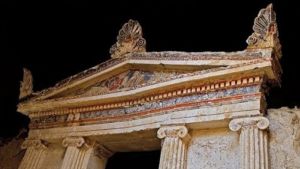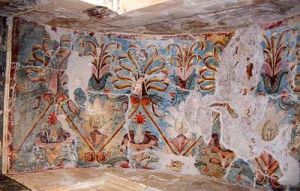Difference between revisions of "Language/Modern-greek-1453/Culture/Tomb-of-the-Palmettes-Mieza-Grèce"
| Line 1: | Line 1: | ||
[[File:ΤΑΦΟΣ-ΑΝΘΕΜΙΩΝ-1-678x381.jpg|thumb | [[File:ΤΑΦΟΣ-ΑΝΘΕΜΙΩΝ-1-678x381.jpg|thumb|The facade of the Tomb of the Palmettes.]] | ||
The '''Tomb of the Palmettes''' in Mieza, Greece, stands as a remarkable testament to the architectural and artistic achievements of the Hellenistic period in the ancient Macedonian kingdom. Discovered in the lush landscapes that once cradled the educational endeavors of Aristotle with Alexander the Great, this funerary monument captivates historians, archaeologists, and visitors with its well-preserved structure and exquisite decorative elements. Dating back to the first half of the third century BC, the tomb, alongside others such as the Tomb of Judgment, delineates the rich cultural and historical tapestry of the region. This article delves into the architectural details, historical context, and ongoing preservation efforts that highlight the significance of the Tomb of the Palmettes as a cultural heritage site and a window into Macedonia's illustrious past. | The '''Tomb of the Palmettes''' in Mieza, Greece, stands as a remarkable testament to the architectural and artistic achievements of the Hellenistic period in the ancient Macedonian kingdom. Discovered in the lush landscapes that once cradled the educational endeavors of Aristotle with Alexander the Great, this funerary monument captivates historians, archaeologists, and visitors with its well-preserved structure and exquisite decorative elements. Dating back to the first half of the third century BC, the tomb, alongside others such as the Tomb of Judgment, delineates the rich cultural and historical tapestry of the region. This article delves into the architectural details, historical context, and ongoing preservation efforts that highlight the significance of the Tomb of the Palmettes as a cultural heritage site and a window into Macedonia's illustrious past. | ||
| Line 8: | Line 8: | ||
Discovered in 1971 following unauthorized excavations, the Tomb of the Palmettes reflects the Hellenistic period's architectural finesse. It is sometimes referred to as the Rhomiopoulou Tomb, named after its discoverer. To protect it from environmental damage, a protective metal structure was erected over the site in 1988, although restoration efforts are ongoing. | Discovered in 1971 following unauthorized excavations, the Tomb of the Palmettes reflects the Hellenistic period's architectural finesse. It is sometimes referred to as the Rhomiopoulou Tomb, named after its discoverer. To protect it from environmental damage, a protective metal structure was erected over the site in 1988, although restoration efforts are ongoing. | ||
[[File:tombAnthemion_mainpage (1).jpg|thumb | [[File:tombAnthemion_mainpage (1).jpg|thumb|Detail of the palmettes on the ceiling of the antechamber, giving the tomb its name.]] | ||
The tomb's structure features two barrel-vaulted chambers and a temple-shaped façade adorned with four engaged Ionic columns alongside polychrome Ionic and Doric kymatia. Originally, the tomb's entrance was sealed by six large blocks of poros stone. Dominating the one-meter-high tympanum of the pediment is a meticulously painted scene depicting an elderly couple in repose on a symposium couch, clad in chitons and himations with elaborate folds. This scene is accentuated by the pediment's crown of three elegantly painted palmettes, showcasing exquisite chiaroscuro effects. | The tomb's structure features two barrel-vaulted chambers and a temple-shaped façade adorned with four engaged Ionic columns alongside polychrome Ionic and Doric kymatia. Originally, the tomb's entrance was sealed by six large blocks of poros stone. Dominating the one-meter-high tympanum of the pediment is a meticulously painted scene depicting an elderly couple in repose on a symposium couch, clad in chitons and himations with elaborate folds. This scene is accentuated by the pediment's crown of three elegantly painted palmettes, showcasing exquisite chiaroscuro effects. | ||
Latest revision as of 21:15, 24 March 2024
The Tomb of the Palmettes in Mieza, Greece, stands as a remarkable testament to the architectural and artistic achievements of the Hellenistic period in the ancient Macedonian kingdom. Discovered in the lush landscapes that once cradled the educational endeavors of Aristotle with Alexander the Great, this funerary monument captivates historians, archaeologists, and visitors with its well-preserved structure and exquisite decorative elements. Dating back to the first half of the third century BC, the tomb, alongside others such as the Tomb of Judgment, delineates the rich cultural and historical tapestry of the region. This article delves into the architectural details, historical context, and ongoing preservation efforts that highlight the significance of the Tomb of the Palmettes as a cultural heritage site and a window into Macedonia's illustrious past.
Tomb of the Palmettes, Mieza, Greece[edit | edit source]
The Tomb of the Palmettes, also known as the Tomb of the Flowers, stands as one of the most magnificent and best-preserved monuments of ancient Mieza. Located alongside other notable burial sites, such as the Tomb of Judgment, it is situated merely a hundred and fifty meters to the east along the ancient road that connected Mieza with Pella, the historical capital of the Macedonian kingdom. The construction of the Tomb of the Palmettes dates back to the first half of the third century BC, placing it within the same chronological context as the nearby 'Kinch' Tomb.
Discovered in 1971 following unauthorized excavations, the Tomb of the Palmettes reflects the Hellenistic period's architectural finesse. It is sometimes referred to as the Rhomiopoulou Tomb, named after its discoverer. To protect it from environmental damage, a protective metal structure was erected over the site in 1988, although restoration efforts are ongoing.
The tomb's structure features two barrel-vaulted chambers and a temple-shaped façade adorned with four engaged Ionic columns alongside polychrome Ionic and Doric kymatia. Originally, the tomb's entrance was sealed by six large blocks of poros stone. Dominating the one-meter-high tympanum of the pediment is a meticulously painted scene depicting an elderly couple in repose on a symposium couch, clad in chitons and himations with elaborate folds. This scene is accentuated by the pediment's crown of three elegantly painted palmettes, showcasing exquisite chiaroscuro effects.
In the antechamber, the walls are distinctly painted in two halves: black on the lower and white on the upper, separated by contrasting bands. The ceiling captivates with a series of six meticulously depicted flowers interspersed with water-lilies set against a blue-green backdrop, simulating the serene surface of a pond. Separating the antechamber from the main burial chamber is a double marble door, standing 3.50 meters tall and 0.90 meters wide, and embellished with intricate relief motifs.
Within the burial chamber itself, a rectangular stone base remains, which once supported the larnax holding the remains of the deceased. The chamber's vaulted ceiling is plastered in a subtle pale yellow, while the walls mimic marble revetment with their black lower and red upper sections divided by a white band. This unique Ionic decor, notable for its detailed craftsmanship and vibrant colors, provides significant insights into the period's artistic conventions and painting techniques.
Despite multiple incidents of looting throughout history, the tomb still houses sufficient remnants to illustrate the wealth of grave goods it once contained, highlighted by remarkable ivory plaques originally adorning a ceremonial bed.
The Tomb of the Palmettes is currently open to visitors, with future plans to expand the protective shelter and restore the earthen tumulus that once enveloped this historic monument.
Authored by: I. Psarra, Archaeologist
Author[edit source]
- Ευγενική χορηγία που στοχεύει να βοηθήσει μαθητές ή μη, απανταχού της Γης, που επιδίδονται στην εκμάθηση της ελληνικής γλώσσας!
- Contribution bénévole visant à aider les personnes, partout dans le monde, qui sont engagées dans l'apprentissage de la langue grecque !
- Voluntary contribution aimed at helping people, all over the world, who are committed to learning the Greek language!

